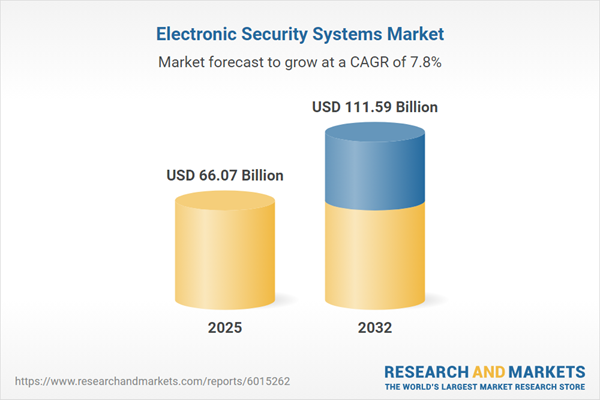Speak directly to the analyst to clarify any post sales queries you may have.
The electronic security systems market is undergoing accelerated transformation as organizations adopt advanced technologies to address an increasingly complex risk environment. Senior decision-makers require integrated, future-ready protection frameworks that enhance detection, facilitate response, and optimize operational efficiency through intelligent solutions.
Market Snapshot: Electronic Security Systems Market Size and Growth
The Electronic Security Systems Market grew from USD 61.34 billion in 2024 to USD 66.07 billion in 2025. It is expected to continue growing at a CAGR of 7.76%, reaching USD 111.59 billion by 2032. Robust market advancement is driven by increasing adoption of cloud connectivity, artificial intelligence-powered analytics, and the convergence of physical and digital security platforms. Organizational priorities are shifting towards unified risk management and seamless integration of legacy systems with next-generation technologies.
Scope & Segmentation of the Electronic Security Systems Market
This report provides comprehensive analysis across diverse system categories, end-user segments, technologies, service models, and geographical regions.
- System Types: Access control (biometric methods such as facial recognition, fingerprint, iris authentication; card-based solutions like magnetic stripe, proximity, smart cards; mobile credentials including BLE and NFC), fire detection and alarm (flame detectors, fixed temperature or rate-of-rise heat detectors, smoke detectors like ionization, photoelectric, multi-sensor), intrusion detection (door/window contacts, glass break, dual-technology, microwave, PIR, vibration sensors), perimeter security (fence-mounted, fiber optic, ground radar, microwave barriers), video surveillance (analog cameras, thermal imaging, IP cameras, PTZ units).
- End Users: Commercial entities (hospitality, office, retail), government and defense (corrections, military, public safety), healthcare (clinics, hospitals, long-term care), industrial (energy, utilities, manufacturing, oil and gas), residential (single-family, multi-family), transportation (airport, railway, seaport).
- Technology Types: Wired infrastructure (copper, fiber optic), wireless solutions (Bluetooth, cellular, RF, Wi-Fi standards including 802.11ac, 802.11ax, 802.11n).
- Service Types: Consulting (risk assessment, system design), installation, maintenance and support (corrective, preventive), system integration (hardware, software integration).
- Regions: Americas (North America, Latin America), Europe, Middle East & Africa (Europe, Middle East, Africa), Asia-Pacific (major economies including China, India, Japan, Australia, South Korea, Indonesia, Thailand, Malaysia, Singapore, Taiwan).
- Leading Companies: Hikvision Digital Technology, Zhejiang Dahua Technology, Robert Bosch GmbH, Honeywell International, Johnson Controls International, Axis Communications, ASSA ABLOY, Hanwha Vision, Teledyne Technologies, ADT.
Key Takeaways for Senior Decision-Makers
- Growing threat complexity makes holistic protection strategies—including advanced sensors and unified management platforms—essential for organizational resilience.
- Technological advancements such as artificial intelligence, machine learning, and IoT integration are driving real-time threat detection and adaptive security responses.
- Greater focus on regulatory compliance and data privacy is shaping product development and system deployment, particularly within regulated industries and public infrastructure.
- The convergence of physical, information, and operational technologies enables cross-departmental collaboration and streamlines incident response for large-scale enterprises.
- Regional dynamics influence adoption patterns: North America emphasizes compliance and infrastructure investment, Europe and the Middle East advance privacy-focused integration, and Asia-Pacific leads in rapid deployment and smart city innovation.
- Alignment between supply chain management, robust cybersecurity measures, and ongoing service provision ensures sustained competitive advantage and customer loyalty.
Tariff Impact on Global Supply Chains
United States tariffs enacted in 2025 have elevated procurement costs and extended project timelines for sensors, cameras, and control hardware. Industry stakeholders are mitigating these pressures through strategic inventory management, diversified sourcing, and increased investment in domestic production capabilities. Such adaptations are resulting in more resilient and flexible supply chain networks across global regions.
Methodology & Data Sources
This analysis leverages a blended methodology of primary research—via interviews with senior executives, integrators, end users, and regulatory experts—and secondary sources, including industry reports, patent filings, and government regulations. Data validation uses advanced scenario modeling and cross-verification by subject matter experts to ensure actionable accuracy for all insights presented.
Why This Report Matters
- Enables leaders to align technology investments with evolving risk landscapes, delivering actionable guidance for integrated security adoption and digital transformation.
- Provides in-depth segmentation, revealing the most relevant solutions, service models, and supplier strategies for specific industries, regions, and operational priorities.
- Supports proactive decision-making around supply chain agility, interoperability, and regulatory adherence in a rapidly changing global environment.
Conclusion
As the electronic security systems market advances, senior decision-makers are best positioned by leveraging integrated strategies, adaptive sourcing, and robust service partnerships. These approaches foster resilience, drive innovation, and unlock opportunities amid shifting policy and technology landscapes.
Additional Product Information:
- Purchase of this report includes 1 year online access with quarterly updates.
- This report can be updated on request. Please contact our Customer Experience team using the Ask a Question widget on our website.
Table of Contents
3. Executive Summary
4. Market Overview
7. Cumulative Impact of Artificial Intelligence 2025
Companies Mentioned
The companies profiled in this Electronic Security Systems market report include:- Hikvision Digital Technology Co., Ltd.
- Zhejiang Dahua Technology Co., Ltd.
- Robert Bosch GmbH
- Honeywell International Inc.
- Johnson Controls International plc
- Axis Communications AB
- ASSA ABLOY AB
- Hanwha Vision Co., Ltd.
- Teledyne Technologies Incorporated
- ADT Inc.
Table Information
| Report Attribute | Details |
|---|---|
| No. of Pages | 191 |
| Published | October 2025 |
| Forecast Period | 2025 - 2032 |
| Estimated Market Value ( USD | $ 66.07 Billion |
| Forecasted Market Value ( USD | $ 111.59 Billion |
| Compound Annual Growth Rate | 7.7% |
| Regions Covered | Global |
| No. of Companies Mentioned | 11 |









